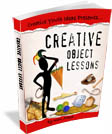
Although gummy bears were invented by German Candy maker Hans Reigel in 1922, the gummy worm is a relatively recent concept. The Gummy bear wasn’t shipped to America until around 1981 and then an American candy company extended the idea to gummy worms to give youth something fun to eat and to shock their parents. Gummy worms are one of the most popular gummy candies around. Use these games with gummy worms as an object lesson to talk about Jesus’ call to his disciples to become fishers of men.
PLEASE SHARE THIS IDEA ON FACEBOOK – CLICK HERE
What You Need
Lots of Gummy Worms
Games using Gummy Worms
NOTE: The intention is for these youth games to be played with gummy worms, but if you can’t get gummy worms, you can use extra long Twizzlers, or string licorice.
- Chicken Races – In this crazy youth game, everyone is a chicken. Place gummy worms in a shallow baking pan with crushed Oreos piled on top and place it at the opposite end of the room. You can use one pan for each team or have them all fight over the worms in a single pan. On “go”, the first team member from each team must flap their arms like wings and make clucking sounds while running to the pan to collect a worm using their mouth (beaks) only. No hands allowed. Once they retrieve a worm they can return to the team and the next youth repeats the task. Worms must still be whole to be counted. The first team to have everyone retrieve a worm wins. Variation: Instead of oreo cookies, use chocolate pudding sprinkled with oreo cookies.
- Chicken Feed – This is similar to the chicken race, but have a deeper pan with more chocolate pudding and Oreos. Each team chooses one representative. The youth who retrieves the most worms from the pan in a designated time wins.
- Worm Fishing – To play this game you fill a fishbowl with pretzels or goldfish crackers, and the youth use a fishing rod to get one out and eat it. The bait is gummy worms that are nice and sticky. If you don’t have a real fishing rod, use a stick and some string. You could even add a reel if you wanted to. If you don’t have a fishbowl handy, any clear, large bowl will do the trick. Use lukewarm water to wet down a gummy worm and then pat it dry so that it’s nice and sticky. Tie the worm to the end of the string on the fishing rod. Players have one minute to use the wishing rod to “hook” a pretzel/goldfish from the fishbowl by getting it to stick to the ooey-gooey gummy worm. No hands allowed. Then, once one is “caught,” it must be brought back to the player’s mouth and she must eat it before the timer runs out in order to win the game. To make it more difficult, increase the distance to the fishbowl. If a pretzel/goldfish falls off the gummy worm it must be abandoned and another one “caught” on the gummy worm. If a player touches the string or gummy worm while a pretzel is attached, that pretzel won’t count. String may not be wound around the finger during an attempt. The player(s) with the most pretzels at the end of the 60-seconds wins.
- Worms between your toes – Fill 5 or 10-gallon buckets (or kiddie pools) about 1/4 of the way up with water and drop at least 20 gummy worms in each one. Everyone takes off their socks & shoes. The first person in line for each team will run to bucket and dip their foot in the water, pulling out a worm with their toes. They must then transfer the worm into a bowl located beside the bucket. Teams only get a point for worms dropped into the bowl. Whoever has the most worms at the end of a designated time limit wins! (If you•re indoors, have some towels on hand for participants to dry their feet. You may also want to lay tarps down to minimize the mess.) Variation: Instead of a bowl, guys lie down with their heads beside buckets. The girls feed them to the guys using only their feet. The girl and guy team who can eat the most gummy bears in 2 minutes wins.
- Gummy Worm Rulers – Provide a list of measurements in gummy worms of various items around the youth room. Youth must find the item that matches the measurements. The team with the greatest number of correctly identified items wins. (Tip: Measure the length of a typical gummy worm and then just measure things in the room with a ruler like the length of a table, the width of a door, the height of a poster, etc. Divide the measurements by the length of a typical gummy worm to get the lengths in gummy worms – 3.5 gummy worms, etc)
- Gummy Relay – Pair up the youth. One end of a gummy bear goes into each person’s mouth. The pairs must then navigate an obstacle course without break the gummy bear or allowing it to drop from their mouths. Fastest pair wins!
- Gummy Worm Race – Placed a marshmallow, a pretzel, or even a donut in the middle of a gummy worm. On go, players must eat their way to be the one to finish off the marshmallow. Whoever eats the marshmallow wins the game. Variation – The team who eats the worm the fastest wins!
- Gummy Worms Pictionary – Played like normal Pictionary where you have to draw the clues for your teams to guess the word or phrase, but in this variation, instead of drawing, lay out the gummy worms to create shapes. No numbers symbols or letters are allowed. You can do it on a cookie sheet, chopping board, or butcher paper.
- Gummy Worm Stretch – In this game, the goal is for partners to have the most stretched-out gummy worm without breaking it. Check your results with a ruler.
- Fishies – Take a couple fishing poles and stick gummy worms to them with string. Blindfold the youth and dangle the gummy worms around. The first person to find the gummy worm with their tongue and eat it, wins.
- Make Dirt Cups as snacks – You’ll need 8-ounce clear plastic cups, chocolate pudding mix, milk (as specified on pudding box) chocolate sandwich cookies like Oreos (crushed) and gummy worms. Mix the pudding according to the package directions. Layer the pudding and the cookie crumbs in cups. Top the layers with more crumbs and gummy worms.
- Gummy Worm Gulpers – Youth race against the clock to eat gummy worms hanging from the ceiling. You’ll need clothespins, strong string, and lots of gummy worms. Cut various lengths of string, attach one end to the ceiling or from a tree and one end to a clothespin, and clamp a gummy worm in each clothespin. Youth run from string to string and, using only their mouths, snatch and eat the gummy worms. The winner is whoever eats all the worms in the shortest amount of time.
TAKE IT TO THE NEXT LEVEL
- How would you describe a gummy worm to someone who has never seen or eaten one before?
- What are some of the characteristics of gummy worms?
- Name some uses of real worms?
- Has anyone ever fished with a worm?
MAKE IT SPIRITUAL
Read Matthew 4:17-22
- Worms are attractive to fish. What are some things that are attractive to people?
- What things does the world go fishing for?
- What are we to fish for as Christians?
- Is a person a fisherman if year after year he never goes fishing?
- Is he a fisherman if he never catches a fish?
- Is someone a true disciple of Jesus Christ if he never attempts to win a soul for Christ?
MAKE IT PRACTICAL
- As a fisherman, do we cast our nets in our backyard or do we go to a place where fish can be found? (Jesus never suggests that the world should come to the church but commands the church to go into the world to witness. Jesus has given us the example – he goes to the people, he never waits for the people to come to Him.)
- How is telling others about Jesus similar to fishing?
- Lures are attractive to fish. How can you make the good news of Jesus attractive to your friends?
MAKE IT PERSONAL
- What can you do this week to be more effective as a fisher of men?
KEY SCRIPTURE
Matthew 4:19: “Come, follow me,” Jesus said, “and I will make you fishers of men.”
PLEASE SHARE THIS IDEA ON FACEBOOK – CLICK HERE
 MORE IDEAS? See “Creative Object Lessons”
MORE IDEAS? See “Creative Object Lessons”
200 page e-book that explains everything you need to know when planning your very own object lessons. It contains 90 fully developed object lesson ideas and another 200 object lesson starter ideas based on Biblical idioms and Names / Descriptions of God.
![]()
